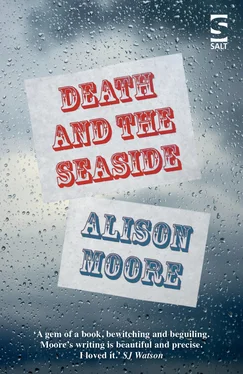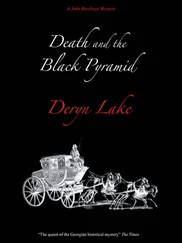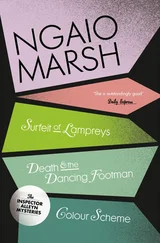In between my first two groups, I ate a sandwich. It was during this break that I realised that I had inadvertently watched the first video alongside Group A: I too had been exposed to the “FAIL” and “JUMP” commands. It felt like having stood in the path of an X-ray, an invisible beam of electromagnetic radiation, without having first put on the lead apron. Or perhaps, I thought, the video would not work on me, if I knew that the subliminal messages were there.
I tidied the room up and noticed that the drawing pad had been left behind. On the front, in untidy handwriting, it said “Bonnie Susan Falls”, and inside she had drawn a series of rectangles.
After lunch, I welcomed Group B, to whom I showed the same film, except that their subliminal messages were negative suggestions: “DON’T FAIL”, in black and white, and “DON’T JUMP”, printed like public notices in front of those open windows and at those cliff edges. I watched it with them, hoping that it might neutralise any effect from the first video, that a positive command and a negative command might cancel each other out. Afterwards, they did the buzz-wire test and answered the questions and again showed not the slightest interest in the window, which I had opened a little wider before they came in.
I had hired the community centre for the whole day, but by the afternoon I was running late. I ought to have hired it for two days, or three, but that would have been more expensive. Also, by the middle of the afternoon, I was out of temper because my experiment was not going as I had hoped. I rushed the control group, who were to watch a version of the video which had no subliminal messages in it. I asked them only a few questions before paying them and sending them home. When I was packing up, I discovered that undoctored version of the video still in my bag, which meant that my “control” group must in fact have seen one of the other videos. Probably, I had accidentally reinserted the version that I had shown to Group A, or perhaps I had neglected to swap the tape at all after the Group B showing. Either way, this meant that I had no control group. But never mind, I thought: the experiment had failed anyway. Slight differences between the groups’ buzz-wire tests were statistically insignificant, and not one of my subjects had even approached the open window. One woman, who at one point I thought was about to, was only fetching her purse from her bag, so as to show another woman a photograph of her new granddaughter. “Oh,” said the other woman, looking at the baby’s picture. “She’s going to be a heartbreaker.”
I typed up my notes, but I was, to be honest, rather put out.
Then, after the passage of some 20 years, I read in the local newspaper about a man who had jumped or fallen from the roof of a car park, and I recognised his name: Eliot Pierce. I dug out my records of my subjects’ names, groupings, test scores, and I found that this man had been in Group C: he had been the youngest member of my control group. I remembered that he had worn glasses, and that the lenses were dirty, smudged: he walked around with a big thumbprint — presumably his own, but possibly somebody else’s — between him and the world. I had wondered whether his glasses would have prevented him from seeing the video properly, whether everything would have looked blurry, but I suppose not.
The Eliot Pierce incident was the first indication I’d had that there might have been a delayed effect, a result which could not be seen or measured at the time of the experiment. I got in touch with his mother, thinking that we could enlighten one another. I explained who I was, but Mrs Pierce was very unhelpful. I then googled the names of the other participants, in all three groups, but found no further relevant information, which meant that the car park jump was not statistically significant.
At that time, I was living in a house on Slash Lane, which I had converted into flats. The letting was dealt with by an agent — I did not want tenants knocking on my door complaining about blocked toilets or burst pipes. After the student in the ground-floor flat decided to move out, I acquired a new downstairs tenant, who I saw on occasion, when looking out of my front window. She had been in the house for a little while before I found myself going through her paperwork, looking at her name: Falls, Bonnie. As soon as I made the connection, I started to watch her. I observed her coming home from work at the same time every evening, disappearing into the passageway like Mr Hyde heading to his back door.
I made contact, and through Bonnie have had the opportunity of again meeting Mrs Falls, on whom I can see that my subliminal commands had no effect at all.
This reacquaintance with my old experimentees has also brought to mind my little brother’s friend, who proved to be a far more cooperative subject for hypnosis than my brother ever was. What I did not know back then is that some people are simply more suggestible than others: they have a suggestible personality, a “hypnotic susceptibility”. Hypnosis works “because the subject believes the process is effective” (Brown, Tricks of the Mind ). On the other hand, you can hypnotise a chicken. I understand, though, that this is rather different: the chicken, sensing a threat, enters into a state of semi-paralysis and plays dead. Having failed to hypnotise my brother, and subsequently the cat, neither of them a willing subject, I had more success with my brother’s friend, dabbling with hypnosis, the inducement of trance-like states, and post-hypnotic suggestion. I have not thought of him in all this time and now find myself wondering how he is doing.
I have also, of course, had the chance to get to know Bonnie, who was not really a member of the group but who was there at the back of the room throughout the Group A session, doodling in her little book, drawing shapes like that of the television screen at which she kept looking.
At the age of 30, she is inclined to failure. She is drawn, even in her sleep, to windows and edges, and has been known to jump.
On Monday morning, Bonnie woke up later than she had intended to — it was after nine o’clock — but when she looked out of the front window, she saw that Sylvia was not yet there with the hire car.
Bonnie got dressed and was about to start packing when she realised that she did not have a suitcase. She emptied the dressing-up costumes out of the suitcase in the lounge and used that. She had left her mobile phone charging overnight, and she now unplugged it and put it into her shoulder bag so that she would not forget to take it.
In the middle of the morning, Sylvia pulled up at the kerb and got out of the car looking unusually flustered.
‘I’m sorry I’m late,’ said Sylvia. ‘I just had a few things to finish off.’
‘It’s fine,’ said Bonnie. ‘I’m not ready either.’ Most of the clothes that she had been planning on bringing were still hanging damp on the line in the yard. She packed them anyway and carried the costumes suitcase out to the car. Lifting it into the boot, she said, ‘Have I forgotten anything?’
‘If you have,’ said Sylvia, ‘I’m sure you’ll manage.’
‘Is that water?’ said Bonnie, spying the plastic containers that Sylvia had got in the boot, underneath her own suitcase.
‘Be prepared,’ said Sylvia, closing the boot. ‘We ought to get going.’
‘Oh wait!’ said Bonnie. ‘I knew I’d forgotten something. I’ll just be a minute. Come inside and sit down.’ Sylvia went with Bonnie back inside the flat, although she did not sit down or take off her jacket, but stood near the door while Bonnie spent a while digging out wellies and waterproof trousers and a waterproof coat. ‘You’re quite right,’ said Bonnie. ‘You never know what’s going to happen.’ Eventually, she set out to the car with her arms full of things that she would not need. Halfway down the passageway, she heard her phone ringing, her landline, or perhaps it was her neighbour’s phone. Either way, it soon stopped, and Bonnie had almost reached the car when half the things she was carrying fell into the gutter. With her hair falling into her face, she picked everything up again and put it in the car. Was that everything now? She returned to the house, saying, ‘I think I really have remembered everything now.’
Читать дальше












